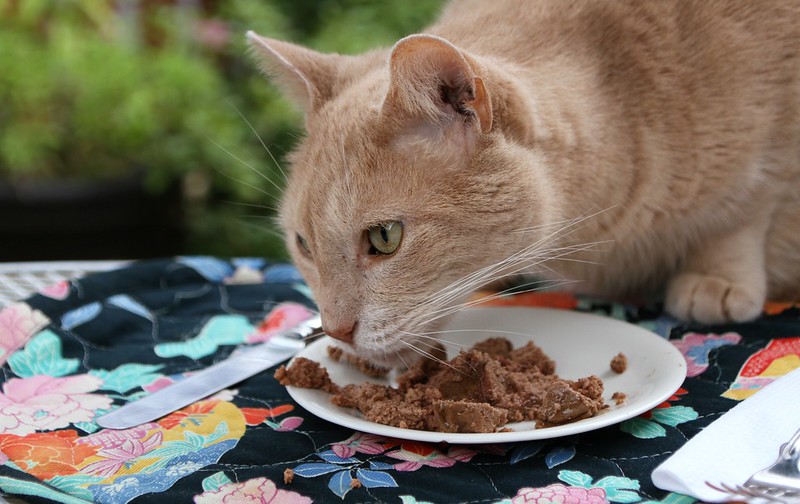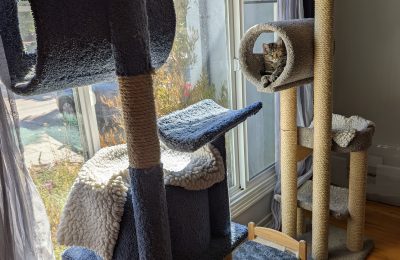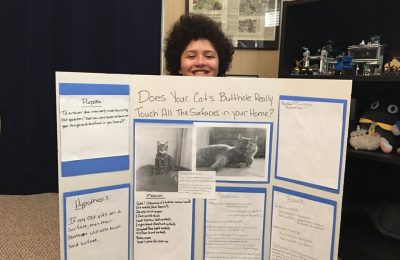Science says yes (at least for older cats).
As cats get older, a common issue is getting them to eat enough food to maintain their weight. There are multiple reasons that senior cats might not eat as robustly, including medical issues, declining senses, and a decreased ability to digest food. A recent study, “Aging cats prefer warm food,” looked at whether a simple intervention (warming a cat’s food) would increase food intake in older cats. It’s been hypothesized that cats might prefer food that is “prey-temperature” – that is, that would resemble the temperature of freshly killed prey.
Thirty-two cats between 8 and 14 years of age participated in the study, which utilized a commercial wet diet of “chunks in gravy.” In each case the researchers offered equal amounts of food at two of three different temperatures: approximately 42, 69, or 98 degrees F. Each cat received each combination of temperatures (i.e., 42 and 69; 42 and 98; 69 and 98) on different days. The researchers measured how much of each temperature food was consumed during each trial.

The cats overwhelmingly chose the warmer of two foods offered at each trial, and they tended to eat more of the food that had been warmed to ~98 degrees. Cats especially did not seem fond of the coldest food.
As it is likely that warming food might change some of its qualities, the researchers also investigated the effect of temperature on the viscosity of the food, as well as on some of its chemical properties.
Viscosity refers to the thickness of a fluid, and how it flows. The scientists first separated the gravy from the chunks, then cooled or heated it to the tested food temperatures. The gravy was next assessed using a fancy-sounding tool called a viscometer. Results suggested that temperature had no impact on the gravy texture. Based on this finding, we can rule out the effects of temperature on the gravy as an explanation for why cats preferred the warmer food.
The researchers looked at the effect of temperature on other properties of food, namely the smell and taste (which they referred to as the “volatile profile”). I’m no food chemist, but their methods involved a process called gas chromatography, which is a process that can separate and measure the chemicals in a substance (it’s definitely in the “don’t try this at home” category of science). By testing the chunks and gravy at the three different temperatures it was determined that temperature does in fact impact the volatile profile of cat food.
The biggest findings were increases in chemicals called hexonoic acid and S-compounds. Hexanoic acids have been found to be attractive to dogs, and are associated with the flavors of foods such as cheese and things that are pungent. S-compounds are associated with things that are savory, roasted, and perhaps most importantly, meaty.
Simultaneously, warming the food decreased the levels of terpenes and hexanal. Terpenes are associated with some citrus flavors, and hexanal is released when fats become rancid. As cats tend to dislike citrus, and likely aren’t attracted to a signal for rancidity, it makes sense that decreasing these chemicals might make the food seem more tasty.
The researchers didn’t test cats who were younger than 8, so we don’t know if warming food is just good for “fussy aging cat” or for any cat. If it makes food taste better, perhaps all cats would enjoy a gently-warmed meal. But if you do have a cat who is a picky eater, my two first recommendations: (1) talk to your veterinarian about it to make sure there’s not a medical reason for the fussiness, and (2) try a few seconds in the microwave or over a warm water bath to see if that increases the food’s appeal to your cat.
Some cats may also prefer a slightly elevated bowl, or even a plate (see my previous blog on whether “whisker stress” is real). I’ve also found that some cats do well with a food “topper” such as dehydrated chicken or bonito flakes to pique their interest. In general, I don’t recommend adding water to food as it changes the texture and possibly the taste and protein concentration, which cats may be sensitive to (although I’m sure there are some cats who do not mind the extra water).
Reference: Eyre, R., Trehiou, M., Marshall, E., Carvell-Miller, L., Goyon, A., & McGrane, S. (2021). Aging cats prefer warm food. Journal of Veterinary Behavior.
Note: the research was conducted by researchers at WALTHAM/Royal Canin.



I have found this consistently over the years with a regular parade of aging cats and also cats recovering from illness or with a medical condition such as renal failure. I find that heating a small amount of cat food in the microwave is a touchy business for achieving the right temperature and not drying out parts of the food, especially with repeated reheating as many cats with appetite issues, whether from aging or illness, often don’t finish all the food and if they like the food I’ll keep it.
I have used the warm water bath, but I do add water or homemade meat stock to all my cats’ food, always pate, with every meal. I know this may somewhat change the composition of the food, but I’ve also found that the addition of liquid seems to make it more palatable for all ages. I add it individually to their regular servings of food so they are eating an appropriate amount of food. When I use meat stock I always heat that and pour it into the food and mix it so that the stock itself warms the pate.
Thanks for the information you share on everyday cat health and behavior. Little things done every day are what helps your cat have a healthy life, and I feel they also extend life.
I agree with Bernadette that adding chicken broth or a bone broth (low or no added salt and no onions or garlic seasoning) greatly increases palatability for older cats and especially older cats w/ renal insufficiency issues. Many pate cats foods are very solid at room temperature and adding hot broth with stirring makes a much more palatable meal. Warm to room temperature foods are accpted much more than refrigerator cold foods. All my cats prefer shallow saucer plates to bowls for wet foods.